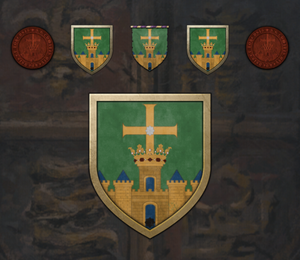Kambut
The city of Kambut (كمبوت) is a medium-sized Egyptian colony located in Libya, west of Tobruk. It was created on 25/03/2024 by Guirod1. Guirod1 was a really recent member of Egypt at the time, with his only main feat prior to the creation of the city being the construction of a small village located in the far western border of Alexandria, where he initially started off as a resident.
History
- Prior to Kambut's creation, Libya was separated into two majors regions: Cyrene and Syrte (included the towns of Benghazi, Tukrah, Ajdabiya and El-Bayda) and Upper Libya, which was contested by the Egyptian city of Tobruk and the Greek colony of Mersa Matruh. Kambut would be created in order to provide a fortified land bridge between Cyrene and Upper Libya, connecting half of Northern Africa in one big line of coastal settlements.
Prior to the settlement of Kambut, the region was occupied with ruins of a medium sized village, though to have been an old colony of the Old Kingdom of Chad, abandoned after the Chadian-Egyptian wars.
The Shield of Egypt
- Right from its initial conception, the city was planned to be centered around one giant complex of ramparts: Fort Vandeleeh. The name "Vandeleeh" derives from the combination of the words ``Vandalia" and "ehh", respectively meaning "The Land of the Vandals" (germanic barbarians who invaded Northern Africa during the fall of Western rome) and the Suffix "ehh", which is a tribute to the royal suffix of the egyptian royal family. Fort Vandeleeh would also be known as "The Blue hold", a reference to the "White Hold" located on Tobruk.
Coat of arms
- Kambut´s coat of arms is full of symbolisms, them being:
- The Golden blue castle. It's a representation of The Blue Hold. The golden walls of sandstone represent prosperity while the blue carvings stand for the Mediterranean's water, which in most of symbolistic theory, represent purity from sin and cleansing.
- Behind the fort lies a green background, representing the Kingdom of Egypt and the Fort's role to stand by it.
- Cross with a crown. Represents the crucifixion cross of Jesus Christ and his rank of "King of Kings"; the cross stands above the castle and in front of the background, implying its importance.
- The White charge on the middle of the cross. Represents the martirization of Saint Augustine, the patron saint of the city and one of the apostles who spread the gospel across Africa and Persia. Consequently, it implies honor, morality and an example to follow.
- The Black charge on the castle's door. Represents all forms of sin and temptation. It is blockaded by the Fort, but its position next to the door and subtle nature imply its constant presence and a reason for the Fort's existence.
The Blue turbans
- The Blue turbans, along with their center of operations, were integrated on Kambut on 09/04/2024. The Blue Turbans are a Christian holy order, whose existence (fictional) goes back to the first crusade, where crusader parties from the new found states migrated all across Africa and Egypt in the form of occult bands.
Military complex
The Blue Hold is one of the largest fortifications of its region, with its 6x7 chunk area and walls reaching over 20 blocks tall. The Blue Hold has a number of facilities dedicated for the Blue Turban's operations and day-to-day life, such as:
- The Blue Turban HQ, which serves as a training ground and a holding for the Blue Turban ranks to see their ongoing missions and contract.
- The Sapphire Armory, the long building located on the fort's western wing, serves as an armory, supply storage facility, bank/treasury and museum.
- Blacksmith district, located on the northern wing, consists of a number of properties which are leased for artisans and metalsmiths under the Blue Turban's ranks. They serve as stations for repair and special commissions of weapons/items.
